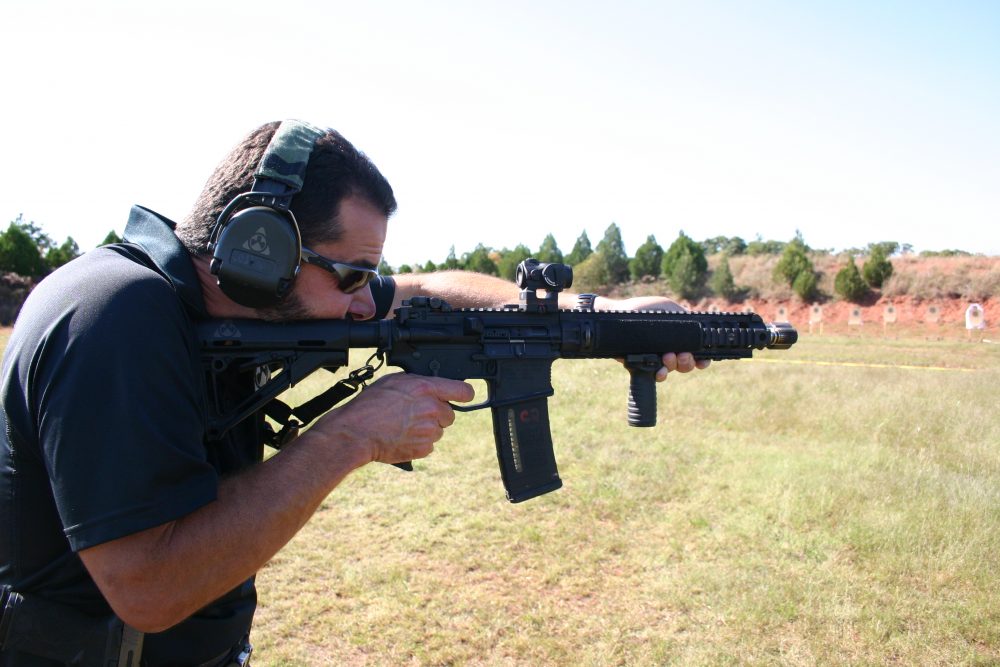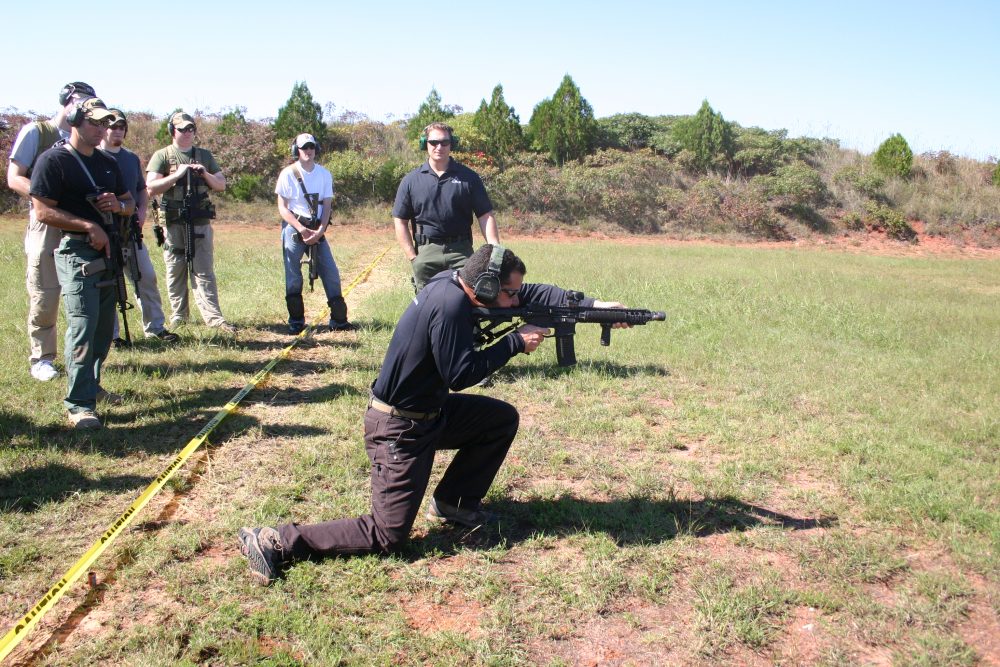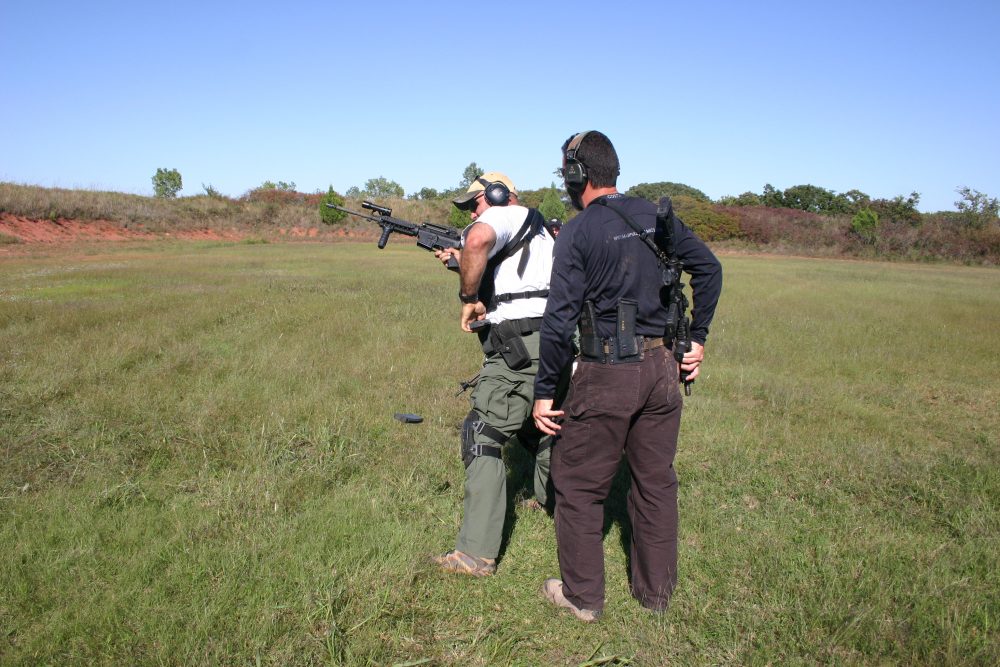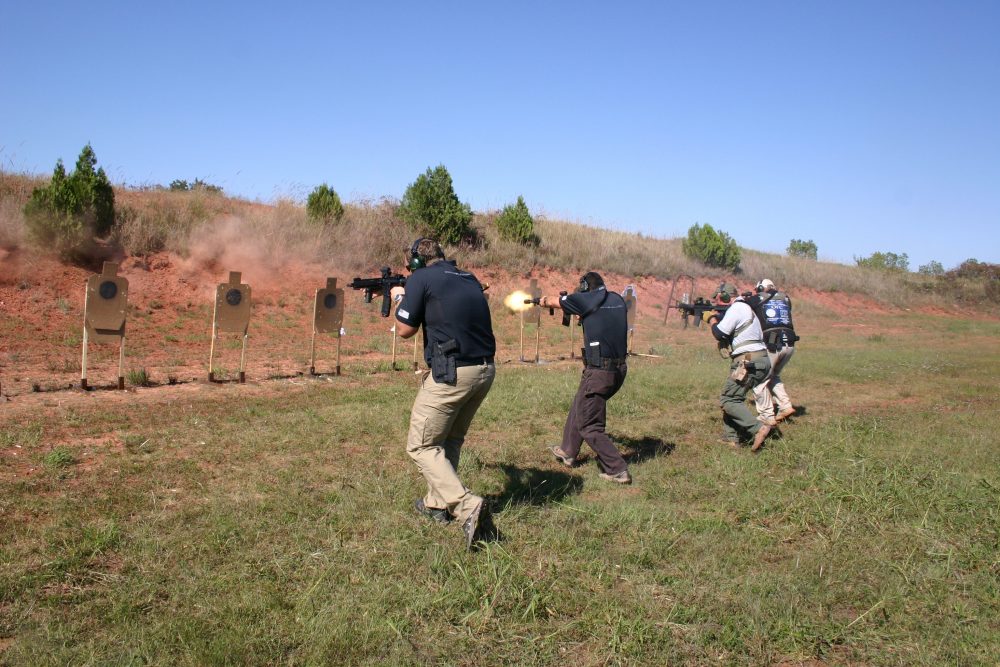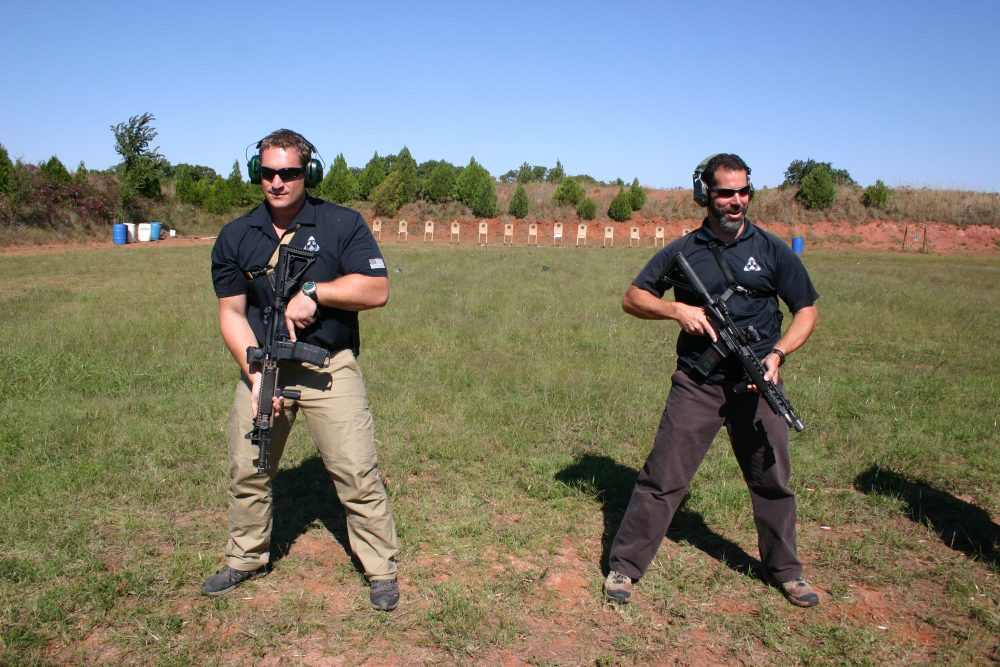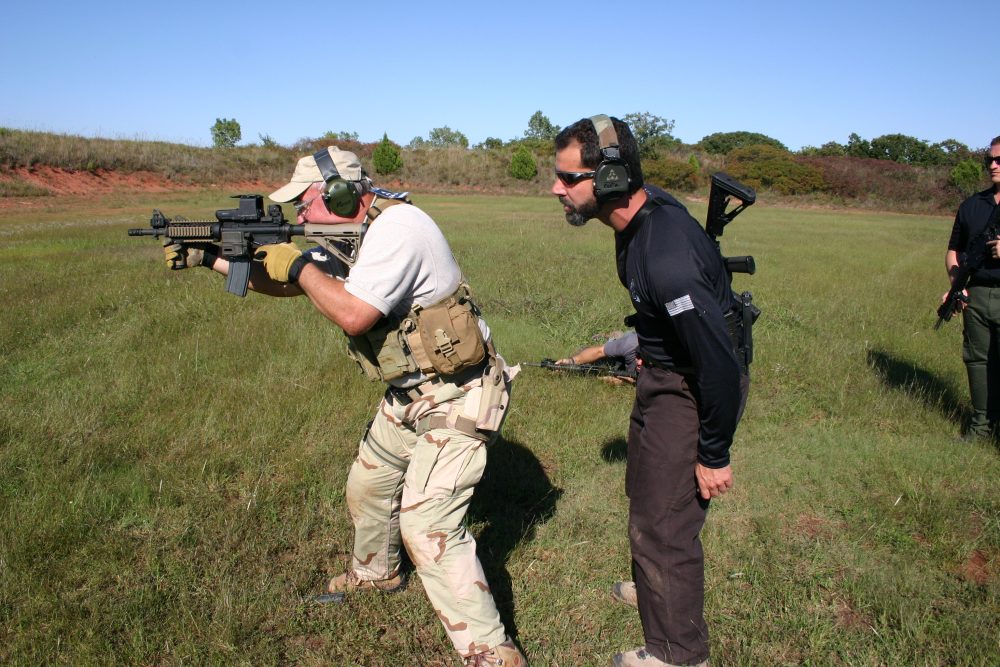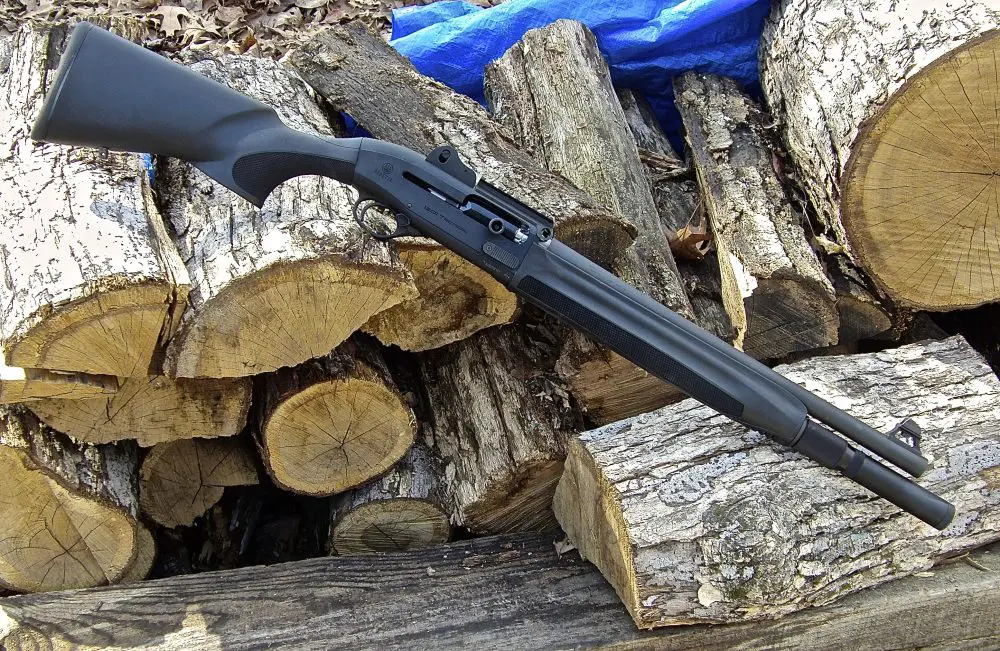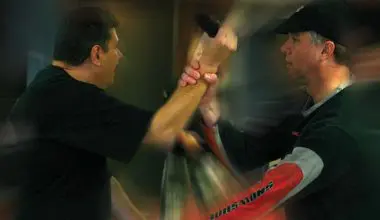The firearms training industry has experienced enormous growth in the past decade with some tremendously qualified instructors and groups, including many with recent combat experience in elite units.
One such organization, Magpul Dynamics, has exploded onto the training scene propelled by positive reviews and high-speed videos. Magpul Dynamics represents the synthesis of Travis Haley and Chris Costa as the training arm of Magpul Industries. Both Costa and Haley bring real-world combat experience and a strong instructional background to their curriculum.
Costa adjusts student’s hold on gun.
Table of Contents
BACKGROUND
Haley served as a Marine Recon and a contractor. In the latter capacity he distinguished himself as the famed “Blackwater Sniper” in Al Najaf, Iraq in 2004, where a forward operating base was in danger of being overrun, and Travis was helicoptered in with an SPR to turn the tide.
Costa’s background includes over ten years with the Coast Guard, where he worked on training and joint operations with law enforcement agencies from many countries and with the Navy Special Warfare Community. He also has operational experience as a contractor for various U.S. government agencies as well as training domestic law enforcement agencies and SWAT teams in subjects ranging from active shooter to counterterrorism. Costa possesses boundless energy that is readily apparent whether he is demonstrating, teaching or even speaking on the phone.
Mike Lamb, a Marine Recon combat veteran who worked his way up to Captain from the enlisted ranks, joins the two. While Lamb may be the new man on the team, he certainly isn’t new to instructing. He and Costa co-taught our class and seamlessly passed the instructional ball between them.
Costa demonstrates hold on carbine in offhand position.
TRAINING PHILOSOPHY
For the Dynamic Carbine 1 class, they condensed into two days training that would take four to six weeks to cover in depth, concentrating on the most essential material and the core principles—reality, consistency, and efficiency—while focusing on the elusive mix of speed and accuracy.
Their goal is to train for worst-case scenarios employing weapons manipulations and skills that they have personally found to be at least 98% effective in combat. They strive to teach TTPs people can apply under stress—ones that work with the body’s natural alarm responses. If something does not meet these criteria, they don’t teach it.
Pushing people beyond their failure point to promote growth is a cornerstone of Magpul Dynamics’ training philosophy. “If you stay where you are comfortable, you will never grow,” Costa asserts. He is fond of stating that “professionals train until they get it wrong,” meaning that they constantly push themselves beyond their failure points. He stressed that if you are shooting a drill perfectly with any regularity, you are probably not pushing yourself hard enough. Then it becomes time to reduce the time limit, increase the number of rounds fired in that time limit, or increase the distance.
In keeping with this philosophy, Costa isn’t as interested in seeing how you perform when your firearm is working properly as he is in seeing how you manage when experiencing problems, and how quickly and effectively you deal with those problems. This is another reason Magpul’s instructors insist on pushing people beyond their failure points: to build experience in solving problems under stress.
Costa shows unbraced kneeling position to students.
MAGPUL TTPs
Consequently, students must be willing to let the Magpul Dynamics instructors push them past their personal point of failure if they hope to improve. The instructors recognize that theirs is a way rather than the way, and that some of the TTPs they introduce may be quite different than what students are accustomed to, so they ask that students try to do things the instructors’ way for the duration of the course.
A prominent feature of the shooting platform they teach is an aggressive forward hold, with the support hand grasping the handguard as far out as possible. This serves to maximize controllability and enable the shooter to get multiple consecutive hits when firing as fast as possible, as well as to drive the gun from target to target. For controlling recoil, they point out, the upper body is more important than the lower body.
Costa demonstrated the stability of this by grasping the gun in this hold and having hulking co-instructor Mike Lamb grab and shake the barrel. He then compared it to when the gun was held with support closer toward the magazine well. Costa used different students’ carbines with different lengths, handrails and setups to demonstrate the optimum hold for each.
Costa oversees student doing mag change.
TIME TO SHOOT
The firing portion of the class began by confirming zero from prone at 50 yards. Once that was done, we moved to firing offhand at five yards, concentrating on the ten-inch circle that constituted the kill zone of the silhouette target. The starting goal was to get two shots in two seconds from a ready position where the carbine was held slightly depressed so that the muzzle was just below the target and the optic just below eye level. As soon as everyone saw how achievable this was, Costa pushed the class to fire as many rounds as possible within the time limit. Costa himself demonstrated getting 11 rounds with this drill. Students were firing six or more rounds without an issue.
Costa asked the class to compare two targets. One had five rounds in it and the other had eight. The target with five rounds had all its hits in the ten-inch circle, while the one with eight had four hits in the circle and four hits outside. Costa pointed out that the outside hits were not that far outside and would certainly have been combat effective, so in this case, the target with eight hits was closer to what he was looking for.
He also pointed out that, while the shooter had fewer hits in the kill zone, he had pushed himself much harder than the person who had fired fewer rounds but achieved 100% hits in the black. The faster shooter now had to focus on accuracy and controlling his gun more, and perhaps reduce his speed to the point where he was getting most of his shots in the circle.
As we concentrated on getting multiple hits in two seconds, Costa walked the line and surveyed each student’s shooting platform. He often stopped to make hands-on adjustments to their stance and hold on the gun and then watched them fire additional rounds to ensure that they were making proper application of his suggestions and to get their feedback about his recommended changes.
Instructors Lamb and Costa demonstrate shooting on the move with students.
MOVING BACK
We then moved farther back and repeated the drill, always two rounds in two seconds and increasing the rounds fired in that time frame until we exceeded our own individual failure points. This of course varied from student to student.
As we moved back, recoil management became more and more important to allow multiple hits to the target’s kill zone. Methods that might have worked at closer ranges would not suffice at greater distances. “Always ask yourself if you are maximizing your ability to control recoil,” Costa admonished the class. He explained that many holds may allow you to deliver one or two rapid shots, but fall apart after that.
This is why he bases his methodology on a hold that allows the delivery of multiple fast shots and not just two. The instructors pointed out that if you find yourself having to reposition your body under higher courses of fire, it is an indication that you were not positioned correctly to begin with.
Magpul Dynamics deliberately runs a high round count to ensure that students get maximum practice in managing their recoil when firing multiple shots. Over the two-day course, each student ran through about 1,400 rounds of ammo, with just about all of the shooting drills involving firing at least two shots from each position.
As we moved away from the targets, the number of rounds we could reliably place in the kill zone within the two-second time limit decreased. The greater the distance from the target, the more important the principles introduced earlier—especially the aggressive forward hold on the forend—became to enable us to deliver maximum rounds in the target’s kill zone in the limited time allowed.
Once the class got farther out, the instructors covered kneeling, prone, urban prone, supine, and various improvised shooting positions. Costa believes that supine is important because it is a position that you might find yourself fighting from after stumbling, falling or otherwise winding up on your back.
Instructors Lamb and Costa about to perform turning drill.
MAGPUL SPEED RELOAD
The first day also covered speed reloads, tactical reloads, malfunction clearances and multiple targets. Magpul Dynamics does not believe in non-diagnostic malfunction clearance, believing that it can result in worsening the malfunction and making an already bad situation worse.
One controversial technique that Magpul Dynamics espouses is their method of executing a speed reload. When the gun runs dry, they advocate tilting the gun enough to be able to visually inspect the ejection port to ensure that the gun is indeed out of ammo as opposed to experiencing a malfunction. Costa believes that this quick check takes only 1/10 of a second and can help avoid mistaking a malfunctioning gun for an empty one, which might make the malfunction worse.
Costa realizes that most people with time on an AR-type weapon can clearly feel when the bolt is locked back, but points out that this may not happen with the adrenaline of an actual gunfight or while wearing heavy clothing, tactical gear or body armor. He recognizes that this is a daylight technique only and not doable if you can’t clearly see your ejection port.
As the day progressed, the class shot Magpul Dynamics’ Balance of Speed and Accuracy drill, also known as the BSA drill. For this drill we shot multiple rounds at targets at distances from five to 75 yards, the latter being the maximum distance that the range setup could accommodate.
At closer ranges, the goal was to fire four rounds at the target’s ten-inch kill zone in two seconds from the ready position. As the distance increased, we were not expected to fire as many rounds, but were encouraged to push it past two. At the 75-yard line, we went from standing to kneeling and standing to prone. While still expected to fire at least two well-placed shots, we were given an additional two seconds to get into the firing positions and complete the task.
Individual help was given to students when necessary.
DAY TWO
The second day began with the BSA drill and a brief review of what we had covered the first day. From there it was on to turning and shooting, which typically involved turning and then assuming a shooting position before firing.
The second day also included a lecture on combat mindset, which, like many aspects of the class, was presented jointly by the instructors.
The lecture contained universal principles that were applicable to anyone who might need to fight with or without weapons, while other elements were particularly applicable to military or law enforcement. The latter was especially pertinent to our 20-person class, which included five LEOs and one Soldier.
The instructors pointed out that the inability to commit until it is too late is a major problem for many people. The instructors also examined a variety of tactical issues, like pointing out that there are little opportunities in real-life situations that you must capitalize on instantly, like an attacker’s mistake or lapse in attention.
Before we tackled shooting on the move, we did some exercises to get a feel for what it’s like to shoot with adrenaline, increased heartbeat and heavy breathing, sprinting 50 yards to the firing line before stopping to fire.
Up until lunch of the second day, the instructors had us leave our sidearms off to ensure that we would concentrate on doing everything with our rifles and not default to going to our secondary weapons in the event that our primary ran dry or malfunctioned.
Before integrating our sidearms with the rifles, the instructors ran us through some quick drills with just our sidearms to assess our handgun skills and to provide brief remedial work to some students.
In teaching classes, Costa has encountered some students whose handgun skills are lacking, thus he has found it worthwhile to spend a bit of time focusing solely on sidearms before integrating them with rifle work. Costa pointed out that everything they teach on the rifle translates over to a handgun—a weapon more likely to be used by civilians and LEOs than a rifle.
We ended the class with a type of shuttle drill, where the instructors set up plastic barrels at various distances in front of groups of targets to designate shooting positions. The students ran individually from one shooting position to another, stopping to engage the targets at each location.
THE MAGPUL WAY
Magpul Industries has established itself as an innovative company, and Magpul Dynamics has certainly followed suit. Their classes and programs of instruction are constantly evolving based on developments in threats and tactics, and changes in gear. They focus on finding better ways to do things. Thus the class you take today may be different than the one you take a year from now.
In speaking with friends who’ve taken Magpul Dynamics classes and reading after-action reports, I noticed that, while activities may vary from class to class, they always stress the same principles and provide the same high-level training experience that has propelled Magpul’s reputation in such a short time on the training circuit.
SOURCES:
Magpul Dynamics
Dept. S.W.A.T.
P.O. Box 17697
Longmont, CO 80308-0697
(877) 462-4785
www.magpuldynamics.com
Black Hills Ammunition
Dept. S.W.A.T.
P.O. Box 3090
Rapid City, SD 57709-3090
(605) 348-5150
www.black-hills.com


